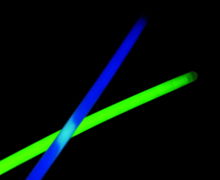Peroxyoxalate
Peroxyoxalates are esters initially formed by the reaction of hydrogen peroxide with oxalate diesters or oxalyl chloride, with or without base, although the reaction is much faster with base:
Peroxyoxalates are intermediates that will rapidly transform into 1,2-dioxetanedione, another high-energy intermediate. The likely mechanism of 1,2-dioxetanedione formation from peroxyoxalate in base is illustrated below:
1,2-Dioxetanedione will rapidly decompose into carbon dioxide (CO2). If there is no fluorescer present, only heat will be released. However, in the presence of a fluorescer, light can be generated (chemiluminescence).
Peroxyoxalate chemiluminescence (CL) was first reported by Rauhut in 1967[1] in the reaction of diphenyl oxalate. The emission is generated by the reaction of an oxalate ester with hydrogen peroxide in the presence of a suitably fluorescent energy acceptor. This reaction is used in glow sticks.

The three most widely used oxalates are bis(2,4,6-trichlorophenyl)oxalate (TCPO), Bis(2,4,5-trichlorophenyl-6-carbopentoxyphenyl)oxalate (CPPO) and bis(2,4-dinitrophenyl) oxalate (DNPO). Other aryl oxalates have been synthesized and evaluated with respect to their possible analytical applications.[2] Divanillyl oxalate, a more eco-friendly or "green" oxalate for chemiluminescence, decomposes into the nontoxic, biodegradable compound vanillin and works in nontoxic, biodegradable triacetin.[3] Peroxyoxalate CL is an example of indirect or sensitized chemiluminescence in which the energy from an excited intermediate is transferred to a suitable fluorescent molecule, which relaxes to the ground state by emitting a photon. Rauhut and co-workers have reported that the intermediate responsible for providing the energy of excitation is 1,2-dioxetanedione.[1][4] The peroxyoxalate reaction is able to excite many different compounds, having emissions spanning the visible and infrared regions of the spectrum,[4][5] and the reaction can supply up to 440 kJ mol-1, corresponding to excitation at 272 nm.[6] It has been found, however, that the chemiluminescence intensity corrected for quantum yield decreases as the singlet excitation energy of the fluorescent molecule increases.[7] There is also a linear relationship between the corrected chemiluminescence intensity and the oxidation potential of the molecule.[7] This suggests the possibility of an electron transfer step in the mechanism, as demonstrated in several other chemiluminescence systems.[8][9][10][11] It has been postulated that a transient charge transfer complex is formed between the intermediate 1,2-dioxetanedione and the fluorescer,[12] and a modified mechanism was proposed involving the transfer of an electron from the fluorescer to the reactive intermediate.[13] The emission of light is thought to result from the annihilation of the fluorescer radical cation with the carbon dioxide radical anion formed when the 1,2-dioxetanedione decomposes.[14] This process is called chemically induced electron exchange luminescence (CIEEL).
Chemiluminescent reactions are widely used in analytical chemistry.[15][16]
References
[edit]- ^ a b M.M. Rauhut, L.J. Bollyky, B.G. Roberts, M. Loy, R.H. Whitman, A.V. Iannotta, A.M. Semsel and R.A Clarke, J. Am. Chem. Soc., 89 (1967) 6515.
- ^ K. Nahashima, K. Maki, S. Akiyama, W.H. Wang, Y. Tsukamoto and K. Imai, Analyst, 114 (1989) 1413.
- ^ O. Jilani, T.M. Donahue, M.O. Mitchell, J. Chem. Educ. 88 (2011), 786-787.
- ^ a b M.M Rauhut, B.G. Roberts, D.R. Maulding, W. Bergmark and R. Coleman, J. Org. Chem., 40 (1975) 330.
- ^ P.A. Sherman, J. Holtzbech and D.E. Ryan, Anal. Chim. Acta, 97 (1978) 21.
- ^ P. Lechtken and N.J. Turro, Mol. Photochem., 6 (1974) 95.
- ^ a b K. Honda, K. Miyaguchi and K. Imai, Anal. Chim. Acta, 177 (1985) 111.
- ^ G.B. Schuster, Acc. Chem. Res., 12 (1979) 366.
- ^ E.A. Chandros and F.I. Sonntog, J. Am. Chem. Soc., 86 (1964) 3179.
- ^ J.W. Haas and J.E. Baird, Nature (London), 214 (1967) 1006.
- ^ D.M. Hercules, Acc. Chem. Res., 2 (1969) 301.
- ^ M.M. Rauhut, Acc. Chem. Res., 2 (1969) 80.
- ^ F. McCapra, Prog. Org. Chem., 8 (1973) 258.
- ^ K.W. Sigvardson, J.M. Kennish and J.W. Birks, Anal. Chem., 56 (1984) 1096.
- ^ Procedures for the enhancement of selectivity in liquid phase chemiluminescence detection, Anal. Chim. Acta, 250 (1991) 145-155.
- ^ J.S. Lancaster, P.J. Worsfold, A. Kachanga. Chemiluminescence detection in analytical chemistry, Endeavour, 16 (4) (1992) 194 - 200.
External links
[edit] Media related to Peroxyoxalate at Wikimedia Commons
Media related to Peroxyoxalate at Wikimedia Commons



